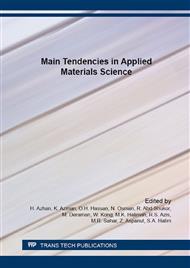[1]
H. Abdullah, M.Z. Razali, S. Shaari, M.R. Taha, Manipulation of MWCNT concentration in MWCNT/TiO2 nanocomposite thin films for dye-sensitized solar cell, Inter. J. Photoener. 2014 (2014) Article ID 673712, 1-9.
DOI: 10.1155/2014/673712
Google Scholar
[2]
S.U. Lee, W.S. Choi, B. Hong, A comparative study of dye-sensitized solar cells added carbon nanotubes to electrolyte and counter electrodes, Sol. Energy Mat. & Sol. Cells 94 (2010) 680-685.
DOI: 10.1016/j.solmat.2009.11.030
Google Scholar
[3]
A. Chrissanthopoulos, S. Baskoutas, N. Bouropoulos, V. Dracopoulos, D. Tasis, S.N. Yannopoulos, Novel ZnO nanostructures grown on carbon nanotubes by thermal evaporation, Thin Sol. Films 515 (2007) 8524-8528.
DOI: 10.1016/j.tsf.2007.03.146
Google Scholar
[4]
H. Chen, W. Li, Q. Hou, H. Liu, L. Zhu, A general deposition method for ZnO porous films: Occlusion electrosynthesis, Electrochim. Acta 56 (2011) 9459-9466.
DOI: 10.1016/j.electacta.2011.08.037
Google Scholar
[5]
A. Chindaduang, T. Sawatsuk, W. Wongsukkab, C. Sae-Kung, G. Tumcharern, S. Pratonetep, Electron microscopy and optical spectroscopy analyses of carbon nanotube composite electrodes for dye-sensitized solar cells, J. Microscopy. 22 (2008) 23-25.
DOI: 10.1016/j.diamond.2008.10.052
Google Scholar
[6]
S. Chaveanghong, S.M. Smith, J. Sudchanham, T. Amornsakchai, Enhancement of power conversion efficiency of dye-sensitized solar cells by using multi-walled carbon nanotubes/TiO2 electrode, J. Microscopy Soc. of Thailand 4 (2011) 36-40.
Google Scholar
[7]
W-C. Chang, Y-Y. Cheng, W-C. Yu, Y-C. Yao, C-H. Lee, H-H. Ko, Enhancing performance of ZnO dye-sensitized solar cells by incorporation of multiwalled carbon nanotubes, Nanoscale Res. Lett. 7 (2012) 166-172.
DOI: 10.1186/1556-276x-7-166
Google Scholar
[8]
A. Omar, H. Abdullah, S. Shaari, M.R. Taha, Morphological and electron transport studies in ZnO dye-sensitized solar cell incorporating multi- and single-walled carbon nanotubes, J. Phys. D: Appl. Phys. 46 (2013) 165503.
DOI: 10.1088/0022-3727/46/16/165503
Google Scholar
[9]
Y.H. Ko, M.S. Kim, J.S. Yu, Structural and optical properties of ZnO nanorods by electrochemical growth using multi-walled carbon nanotube-composed seed layers, Nanoscale Res. Lett. 7 (2012) 13-18.
DOI: 10.1186/1556-276x-7-13
Google Scholar
[10]
N.P. Ariyanto, H. Abdullah, Fabrication of zinc oxide based dye-sensitized solar cell by chemical bath deposition, Func. Mater. Lett 3 (2010) 303-307.
DOI: 10.1142/s1793604710001457
Google Scholar
[11]
H. Abdullah, A. Omar, M.Z. Razali, M.A. Yarmo, Photovoltaic properties of ZnO photoanode incorporating with CNTs for dye-sensitized solar cell application, Ionics 20 (2014) 1023-1030.
DOI: 10.1007/s11581-013-1038-3
Google Scholar
[12]
H. Abdullah, N.P. Ariyanto, S. Shaari, B. Yuliarto, S. Junaidi, Study of porous nanoflake ZnO for dye-sensitized solar cell application, American J. Eng. & Appl. Sci. 2 (2009) 236-240.
DOI: 10.3844/ajeas.2009.236.240
Google Scholar
[13]
M. Adachi, M. Sakamoto, J. Jiu, Y. Ogata, S. Isoda, Determination of parameters of electron transport in dye-sensitized solar cells using electrochemical impedance spectroscopy, J. Phys. Chem. B 110 (2006) 13872-13880.
DOI: 10.1021/jp061693u
Google Scholar
[14]
W.H. Chiu, C.H. Lee, H.M. Cheng, H.F. Lin, S.C. Liao, J.M. Wu, W.F. Hsieh, Efficient electron transport in tetrapod-like ZnO metal-free dye-sensitized solar cells, Energy & Environ. Sci. 2 (2009) 694-698.
DOI: 10.1039/b902595m
Google Scholar
[15]
W. Feng, Y. Feng, Z. Wu, A. Fujii, M. Ozaki, K. Yoshino, Optical and electrical characterizations of nanocomposite film of titania adsorbed onto oxidized multiwalled carbon nanotubes, J. Phys. Cond. Matt. 17 (2005) 4361-4368.
DOI: 10.1088/0953-8984/17/27/011
Google Scholar
[16]
B. Munkhbayar, S. Hwang, J. Kim et al, Photovoltaic performance of dye-sensitized solar cells with various MWCNT counter electrode structures produced by different coating methods, Electrochim. Acta 80 (2012) 100-107.
DOI: 10.1016/j.electacta.2012.06.127
Google Scholar
[17]
F.J. Zhang, M.L. Chen, W.C. Oh, Fabrication and electrophotolysis property of carbon nanotubes/titanium composite photocatalysts for methylene blue, Bull. Korean Chem. Soc. 30 (2009) 1798-1804.
DOI: 10.5012/bkcs.2009.30.8.1798
Google Scholar
[18]
J. Bisquert, Theory of the impedance of electron diffusion and recombination in a thin layer, J. Phys. Chem. B 2 (2002) 325-333.
Google Scholar
[19]
F. Fabregat-Santiago, J. Bisquert, G. Garcia-Belmonte, G. Boschloo, A. Hagfeldt, Influence of electrolyte in transport and recombination in dye-sensitized solar cells studied by impedance spectroscopy, Sol. Energy Mat. & Sol. Cells 87 (2005).
DOI: 10.1016/j.solmat.2004.07.017
Google Scholar
[20]
Q. Wang, S. Ito, M. Grätzel, F. Fabregat-Santiago, I. Mora-Seró, J. Bisquert, T. Bessho, H. Imai, Characteristics of high efficiency dye-sensitized solar cells, J. Phys. Chem. B 110 (2006) 25210-25221.
DOI: 10.1021/jp064256o
Google Scholar
[21]
F. Fabregat-Santiago, J. Bisquert, E. Palomares, L. Otero, D. Kuang, S.M. Zakeeruddin, M. Grätzel, Correlation between photovoltaic performance and impedance spectroscopy of dye-sensitized solar cells based on ionic liquids, J. Phys. Chem. C 111 (2007).
DOI: 10.1021/jp066178a
Google Scholar
[22]
A.B.F. Martinson, M.S. Góes, F. Fabregat-Santiago, J. Bisquert, M.J. Pellin, J.T. Hupp, Electron transport in dye-sensitized solar cells based on ZnO nanotubes: evidence for highly efficient charge collection and exceptionally rapid dynamics, J. Phys. Chem. 113 (2009).
DOI: 10.1021/jp810406q
Google Scholar
[23]
K.M. Lee, C.W. Hu, H.W. Chen, K.C. Ho, Incorporating carbon nanotube in a low-temperature fabrication process for dye-sensitized TiO2 solar cells, Sol. Energy Mat. & Sol. Cells 92 (2008)1628-1633.
DOI: 10.1016/j.solmat.2008.07.012
Google Scholar


